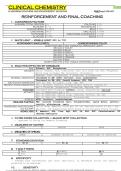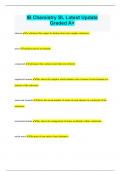The BEST VIEW comes AFTER THE HARDEST CLIMB . If you’re lost along the way, always ask for His guidance. God always provides. Prepared by: JACQUE ANDREI V. RAMOS, RMT, MLS (ASCPi)CM 1 CLINICAL CHEMISTRY KLUBSYBEAR COACHING AND ENHANCEMENT SESSIONS #RMTnasaJANUARY REINFORCEMENT AND FINAL COACHING 1. CONVERSIO N FACTORS ALBUMIN, TOTAL PROTEIN 10 CALCIUM 0.25 BILIRUBIN 17.1 MAGNESIUM 0.5 CHOLESTEROL 0.0264 BUN 0.357 CREATININE 88.4 URIC ACID 0.0595 THYROXINE 12.9 CREATININE CLEARANCE 0.0167 GLUCOSE 0.055 IRON 0.179 2. WHITE LIGHT or VISIBLE LIGHT : 400 to 700 APPROXIMATE WAVELENGTH CORRESPONDING COLOR LESS THAN 380 NOT VISIBLE (ULTRAVIOLET LIGHT) 380 -440 VIOLET 440 -500 BLUE 500 -580 GREEN 580 -600 YELLOW 600 -620 ORANGE 620 -750 RED MORE THAN 750 NOT VISIBLE (INFRARED LIGHT) 3. ANALYTES AFFECTED BY VARIABLES AGE Albumin, ALP, Phosphorous GENDER Males: Albumin, ALP, Creatinine, Ca2, Uric acid, CK, AST, Phosphate, Blood urea nitrogen, Mg, Bilirubin, cholesterol Females: Iron, cholesterol, Y globulins, a -lipoprotein DIURNAL VARIATION Increased in AM: ACTH, Cortisol, Iron, Aldosterone Increased in PM: ACP, Growth hormone, PTH, TSH DAY -TO-DAY VARIATION >20% for ALT, Bilirubin, iron, TSH, TAG RECENT FOOD INGESTION Inc.: Glucose, Insulin, Triglycerides, Gastrin, Ionized Ca Dec.: Chloride, Phosphorous, Potassium, Amylase, ALP POSTURE Increased when standing: Albumin, Chole, Aldosterone, Calcium ACTIVITY Inc. in Ambulatory pxn.: CK Inc. w/ Exercise: Lactic acid, Creatine, Protein, CK, AST Dec. w/ Exercise: Cholesterol, Triglycerides STRESS ACTH, Cortisol, catecholamines REQUIRE FASTING FBS, Glucose tolerance test, Triglycerides, Lipid panel, gastrin, insulin, aldosterone, renin ANAEROBIC AND REQUIRE ICE SLURRY Lactic acid, Ammonia, blood gas (if not analyzed within 30 min = dec. pH& Po2), iCa (heparinized whole blood if not analyzed within 30 mins). HEMOLYSIS K, Ammonia, PO4, Iron, Mg2, ALT, LD, ALP, ACP, Catecholamine, CK (marked hemolysis) 4. FILTER PAPER COLLECTION or BLOOD SPOT COLLECTION : - Specimen of choice for Newborn Screening 5. MEASURES OF CENTER MEAN MEDIAN MODE 6. MEASURES OF SPREAD : RANGE STANDARD DEVIATION COEFFICIENT OF VARIATION 7. STANDARD DEVIATION 1SD: 68.3% 2SD: 95.4% 3SD: 99.7% 8. T AND F TESTS T Test ACCURACY MEAN F Test PRECISION SD 9. SPECIFICITY - freedom from interference and cross reactivity, to determine solely the analyte purported to be measured 10. SENSITIVITY - the ability to detect small concentrations of the measured analyte The BEST VIEW comes AFTER THE HARDEST CLIMB . If you’re lost along the way, always ask for His guidance. God always provides. Prepared by: JACQUE ANDREI V. RAMOS, RMT, MLS (ASCPi)CM 2 CLINICAL CHEMISTRY KLUBSYBEAR COACHING AND ENHANCEMENT SESSIONS #RMTnasaJANUARY 11. DIAGNOSTIC EFFICACY COMPUTATIONS DIAGNOSTIC SENSITIVITY Proportion with the disease who have a positive test result TP/(TP + FN) x 100 DIAGNOSTIC SPECIFITY Proportion without the disease who have a negative test result TN/(TP + FP) x 100 POSITIVE PREDICTIVE VALUE Chance with the disease who have a positive test result compared with all individuals who have a positive test result TP/(TP + FP) x 100 NEGATIVE PREDICTIVE VALUE Chance with the disease who a negative test result compared with all individuals who have a negative test result TN/ (TN + FN) x 100 12. PROFICIENCY TESTING (EXTERNAL QC) - a means of verifying the accuracy of tests; can include participation in an external assessment program, splitting samples with another laboratory, or blind testing of materials with known values PROFICIENCY TEST / EXTERNAL QC BLIND SAMPLES 13. DELTA CHECK - generally performed by comparing an individual patient result throughout the day or week with computer detection of changes from earlier individual patient test results. 14. WESTGARD RULES RULE MEANING DETECTS 12S One observation exceeds 2 SD from the target value. The 12S rule is not recommended because it has an excessive false alert rate. Not recommended except for "low sigma" methods 13S One observation exceeds 3 SD from the target value. Imprecision or systematic bias 22S (22.5S) Two sequential observations, or observations for two QC samples in the same run, exceed 2 SD (or 2.5 SD) from the target value in the same direction. Bias R4S Range between observations for two QC samples in the same run, or for two sequential observations of the same QC sample, exceeds 4 SD. Imprecision 10x or 10m Ten sequential observations for the same QC sample are on the same side of the target value (x or mean). The 10x rule is not recommended because it has an excessive false alert rate. Not recommended 81S (81.5S) Eight sequential observations for the same QC sample exceed 1 SD (or 1.5 SD) in the same direction from the target value. Bias trend CUSUM Cumulative sum of SDI for a specified number of previous results. Bias trend EWMA Exponentially weighted moving average w ith newer results having more influence (weight). Bias trend 15. RANDOM ERROR RANDOM ERROR o reagent dispensing o sample evaporation o temperature of analyzer o electro-optical mechanism o calibrator reconstitution o environmental conditions o instability of instrument o variation in handling techniques: pipetting, mixing, timing o variation in operators VIOLATION error that occurs unpredictably due to poor precision 12S 13S R4S 16. SYSTEMATIC ERROR SYSTEMATIC ERROR o aging reagents o aging calibrators o instrument components o optical changes o fluctuations in line voltage o wear and tear of instrument o reagent lot variability o calibration differences o technologist interactions VIOLATION error that occurs predictably once a pattern of recognition is established; predictable errors of the same sign and magnitude 22S 41S 10X CONSTANT ERROR Type of systematic error in the sample direction and magnitude; the magnitude of change is constant and not dependent on the amount of analyte The BEST VIEW comes AFTER THE HARDEST CLIMB . If you’re lost along the way, always ask for His guidance. God always provides. Prepared by: JACQUE ANDREI V. RAMOS, RMT, MLS (ASCPi)CM 3 CLINICAL CHEMISTRY KLUBSYBEAR COACHING AND ENHANCEMENT SESSIONS #RMTnasaJANUARY PROPORTIONAL ERROR Type of systematic error where the magnitude changes as a percent of the analyte present, error dependent on analyte concentration. 17. TREND a gradual but steady change in quality control results moving up or down away from the mean Values for the control that continue to either increase or decrease over a period of six consecutive days Main cause: DETERIORATION OF REAGENTS 18. SHIFT a sudden and sustained change in quality control results above the mean Six or more consecutive daily values that distribute themselves on one side of the mean value line but maintain a constant level Main cause: IMPROPER CALIBRATION OF INSTRUMENT 19. HORIZONTAL ABSCISSA X-AXIS INDEPENDENT VAR. VERTICAL ORDINATE Y-AXIS DEPENDENT VAR. 20. BIOLOGIC SAFETY CABINET 21. FLAMMABLE/COMBUSTIBLE CHEMICAL o Are among the most hazardous materials in the clinical chemistry laboratory because of possible fire or explosion. o Classified according to flash point, which is the temperature at which sufficient vapor is given off to form an ignitable mixture with air. 22. CORROSIVE CHEMICALS o Injurious to the skin or eyes by direct contact or to the tissue of the respiratory and gastrointestinal tracts if inhaled or ingested. o Typical examples include acids (acetic, sulfuric, nitric, and hydrochloric) and bases (ammonium hydroxide, potassium hydroxide, and sodium hydroxide). 23. REACTIVE CHEMICALS o Are substances that, under certain conditions, can spontaneously explode or ignite or that evolve heat or flammable or explosive gases.





